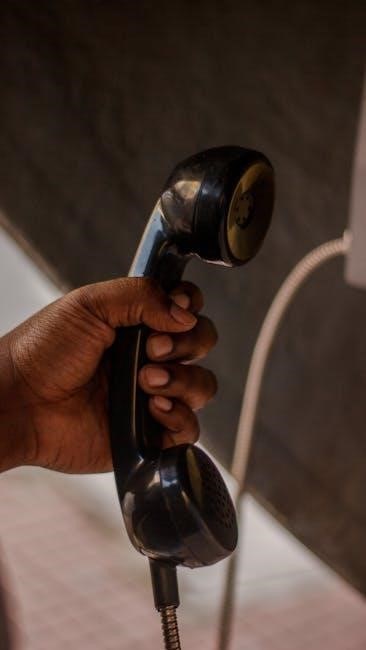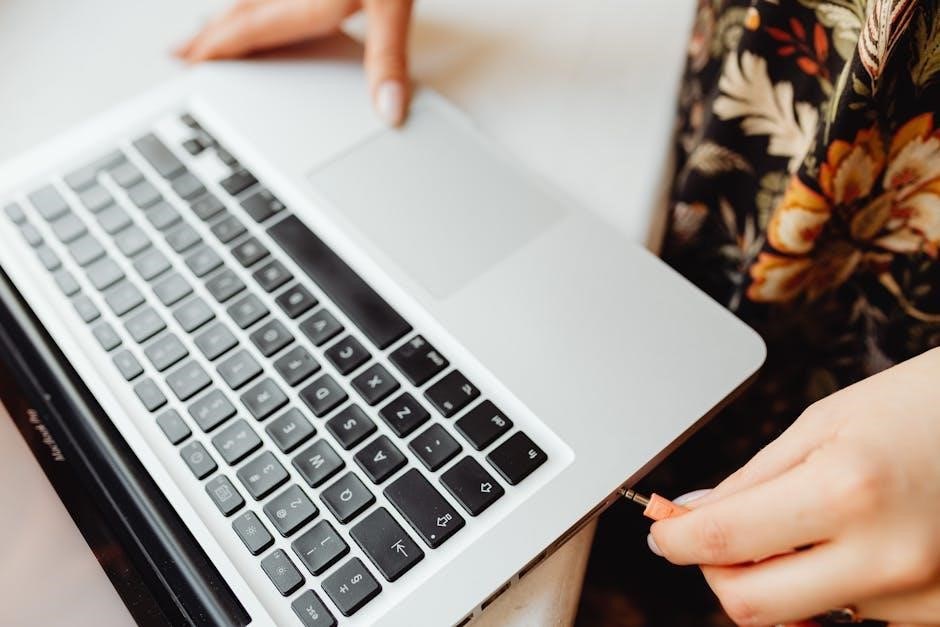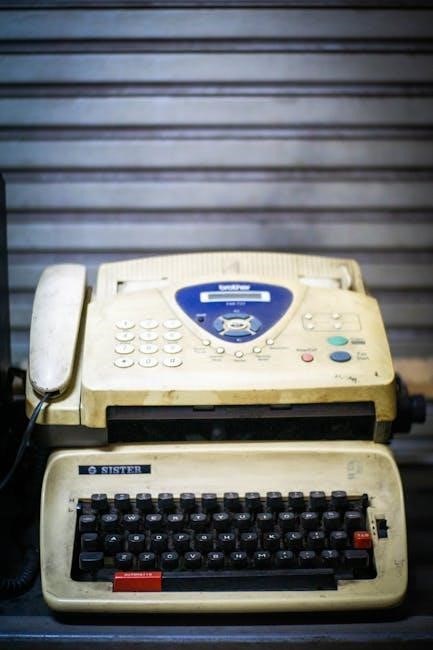Avaya 1416 Phone Manual: A Comprehensive Guide
Welcome to the comprehensive guide for the Avaya 1416 Digital Deskphone! This manual provides instructions, features, and troubleshooting tips․ It helps users maximize their phone’s potential within Avaya systems․
The Avaya 1416 Digital Deskphone is a user-friendly communication tool designed for the Avaya IP Office and Avaya Aura platforms․ As part of the 1400 series, it offers essential features for efficient call handling and communication management․ This phone is ideal for users who require a reliable and feature-rich deskphone solution․
With its 16 programmable buttons, the Avaya 1416 allows for customized call appearances and feature assignments, enhancing productivity and streamlining workflows․ The phone’s interface is designed for ease of use, providing quick access to frequently used functions․ The Avaya 1416 is suitable for businesses seeking a cost-effective, yet powerful, communication solution․ This guide will walk you through the setup, operation, and advanced features, ensuring you get the most out of your Avaya 1416 Digital Deskphone․
Avaya 1416 Features and Overview
The Avaya 1416 Digital Deskphone comes equipped with a range of features designed to enhance communication efficiency․ It boasts 16 programmable call appearance/feature buttons with dual LEDs, providing easy visibility of line status․ A 4-way navigation cluster simplifies menu navigation and feature access․ The phone also includes three context-sensitive softkeys for intuitive operation․
The backlit display ensures clear visibility of call information․ The Avaya 1416 supports a headset jack for hands-free communication․ Its design is tailored for use with the Avaya IP Office and Avaya Aura systems, ensuring seamless integration․ The phone supports both digital and IP connectivity․ Optional button modules can be added to expand the number of programmable buttons․ With its robust feature set and user-friendly design, the Avaya 1416 is a reliable choice for businesses of all sizes․
Initial Setup and Connection
Setting up your Avaya 1416 phone involves several key steps to ensure proper functionality․ First, you’ll need to connect the phone to your network․ Use the provided Ethernet cable to connect the phone’s network port to an active network jack․
Next, configure the IP address․ This might involve manually assigning an IP address or allowing the phone to obtain one automatically via DHCP․ Consult your network administrator for the correct settings․ Following network connectivity, you need to connect the phone to your PBX (Private Branch Exchange)․ This connection allows the phone to communicate with the phone system and utilize its features․
The exact procedure for connecting to the PBX will depend on your system configuration․ Refer to your Avaya system documentation or contact your IT support for specific instructions․ Once these connections are established, your Avaya 1416 phone should be ready for use․
Connecting to the Network
Establishing a network connection for your Avaya 1416 is the first crucial step in the setup process․ Locate the Ethernet port on the back of the phone, typically labeled “Network” or “LAN․” Using a standard Ethernet cable (RJ45 connector), plug one end into the phone’s Ethernet port and the other end into an active network port on your wall or switch․
Ensure the network port you are using is active and properly configured to provide network access․ After physically connecting the phone, observe the phone’s display․ It should indicate that it is attempting to connect to the network․ If the phone does not automatically connect, you may need to configure network settings manually․
This process usually involves setting an IP address, subnet mask, gateway, and DNS server․ Consult your network administrator for these settings, or if your network uses DHCP, the phone should automatically obtain these settings․ A successful connection is indicated by the phone displaying the time and date or other default screen information․

Configuring the IP Address
Configuring the IP address on your Avaya 1416 phone is essential for proper network communication․ If your network uses DHCP, the phone should automatically obtain an IP address․ However, if a static IP address is required, you will need to configure it manually through the phone’s menu․
Access the phone’s menu by pressing the “Menu” button․ Navigate to the “Settings” or “Network” section, and then select “IP Address․” You will be prompted to enter the IP address, subnet mask, gateway, and DNS server provided by your network administrator․
Use the phone’s keypad to enter the numerical values for each setting․ After entering each value, press the “OK” or “Save” button to confirm․ Once all settings are entered, save the configuration and reboot the phone․ After rebooting, the phone should use the configured IP address to communicate with the network․ If you encounter issues, double-check the entered values and consult with your network administrator․
Connecting to the PBX (Private Branch Exchange)
Connecting your Avaya 1416 phone to the PBX (Private Branch Exchange) is crucial for enabling call management features․ Ensure your phone is properly connected to the network and has a configured IP address before proceeding․ Obtain the PBX extension number and any required login credentials from your system administrator․
Access the phone’s menu and navigate to the “PBX Settings” or “Server” section․ Enter the PBX IP address or domain name, followed by the port number if necessary․ Input the extension number assigned to your phone and the password or authentication code, if prompted․
Save the settings and allow the phone to register with the PBX․ The phone should display a “Registered” or “Connected” status upon successful connection․ If registration fails, verify the entered information and network connectivity․ Confirm with your system administrator that the extension is correctly configured on the PBX․ A successful PBX connection enables features such as call transferring, holding, and voicemail access․

Basic Operations
Understanding the basic operations of your Avaya 1416 phone is essential for daily communication․ This section covers making calls, answering calls, placing calls on hold, and transferring calls․
To make a call, simply lift the handset and enter the desired phone number using the keypad․ Alternatively, you can use the programmed speed dial buttons for frequently called numbers․ To answer an incoming call, lift the handset when the phone rings․
To place a call on hold, press the “Hold” button․ The caller will be placed on hold music or a pre-configured message․ To retrieve the call, press the line appearance button associated with the held call․
To transfer a call, press the “Transfer” button․ Enter the extension number you want to transfer the call to․ You can either announce the call or complete the transfer directly․ Press “Transfer” again to finalize the transfer․ These basic operations will allow you to effectively manage your calls․

Making Calls
Making calls on the Avaya 1416 is a straightforward process․ Begin by lifting the handset to get a dial tone․ Once you hear the tone, enter the phone number you wish to dial using the numeric keypad․ Ensure you dial any necessary prefixes or area codes as required․
Alternatively, you can use the speakerphone function․ Press the speakerphone button, and then dial the number․ Speaking clearly into the phone will allow the other party to hear you․ To end the call, simply press the speakerphone button again or hang up the handset․
For frequently dialed numbers, consider programming speed dial buttons․ This will allow you to quickly dial a number with a single press of a button․ Refer to the “Programming Buttons” section for instructions on how to set up speed dial․
Remember to check the call log for recently dialed numbers․ This can save time if you need to redial a number you’ve previously called․ By using these methods, you can efficiently make calls․
Answering Calls
Answering calls on the Avaya 1416 is simple and intuitive․ When a call comes in, the phone will ring, and the call appearance button will flash; To answer the call, you can either lift the handset or press the flashing call appearance button․
If you prefer to use the speakerphone, you can press the speakerphone button when the call comes in․ This allows you to answer the call without lifting the handset, providing hands-free communication․ Ensure that you speak clearly towards the phone’s microphone․
Alternatively, you can use a headset if one is connected․ The process is similar; press the headset button to answer the incoming call․ Adjust the volume as needed using the volume control buttons on the phone․
During an active call, you can switch between the handset, speakerphone, and headset modes by pressing the corresponding buttons․ This flexibility allows you to manage calls in the most comfortable and efficient way․ Always confirm the caller ID if available to ensure you’re speaking with the intended party․
Placing Calls on Hold
Placing a call on hold with the Avaya 1416 is a straightforward process, allowing you to manage multiple calls efficiently․ During an active call, simply press the “Hold” button, which is usually located on the phone’s interface․ The caller will then be placed on hold, and they may hear music or a recorded message, depending on your system’s configuration․
To retrieve a call from hold, press the flashing call appearance button associated with the held call․ This will reconnect you with the caller․ If you have multiple calls on hold, identify the correct call appearance button before pressing it to ensure you retrieve the intended call․
Alternatively, some Avaya 1416 systems may have a dedicated “Retrieve” button․ Pressing this button will typically cycle through the calls on hold, allowing you to select the desired call․
Be mindful of the duration a call is left on hold to maintain good customer service․ Inform the caller before placing them on hold, and thank them for their patience upon retrieval․ Proper hold management enhances the overall call handling experience․

Transferring Calls
The Avaya 1416 phone allows for easy call transfers, enabling seamless communication within your organization․ To transfer a call, first, ensure you are actively speaking with the caller you wish to transfer․ Press the “Transfer” button, typically found on the phone’s button layout; This action will put the original caller on hold․
Next, dial the extension number of the person you want to transfer the call to․ You have two options: you can perform a blind transfer or a warm transfer․ A blind transfer occurs when you immediately press the “Transfer” button again after dialing the extension, sending the call directly to the recipient without announcing it․
For a warm transfer, wait for the recipient to answer, briefly explain who is on the line and why you are transferring the call, and then press the “Transfer” button to complete the process․ This ensures a smoother experience for the caller․
If the recipient is unavailable or declines the call, you can retrieve the original caller by pressing the flashing call appearance button associated with their call․

Advanced Features and Customization

The Avaya 1416 Digital Deskphone offers many advanced features designed to enhance user experience and productivity․ Beyond basic call handling, the phone allows for extensive customization to suit individual needs and workflows․ Users can program buttons for quick access to frequently used features, contacts, or external numbers, streamlining daily tasks․
Customization options include assigning specific functions to programmable buttons, such as speed dial, call forwarding, or direct access to voicemail․ The phone supports personalized ringtones and display settings, allowing users to tailor the device to their preferences․
The contacts list feature enables storing and managing frequently called numbers, facilitating quick and easy dialing․ Call logs provide a detailed record of incoming and outgoing calls, aiding in tracking communication activity․ The menu navigation system grants access to various settings and configurations, enabling users to fine-tune the phone’s performance and behavior․
These advanced features, combined with customization options, make the Avaya 1416 a versatile tool for efficient communication․

Programming Buttons
The Avaya 1416 phone allows users to program its sixteen buttons for customized functionality․ Programming these buttons enhances efficiency by providing one-touch access to frequently used features and contacts․
To program a button, begin by accessing the phone’s menu․ Navigate to the “Button Programming” section․ Select the button you wish to configure․ Choose from a list of available features, such as speed dial, call forwarding, or direct line appearances․ For speed dial, enter the desired phone number․ For features, select the appropriate option from the menu․
After programming, the button will perform the assigned function when pressed․ This customization significantly reduces the time needed to execute common tasks․ Users can reprogram buttons as their needs evolve, ensuring the phone adapts to their workflow․
Properly programmed buttons can transform the Avaya 1416 into a highly personalized and efficient communication tool․ Consult the Avaya support website for advanced programming options and feature codes․
Using the Contacts List
The Avaya 1416 phone features a contacts list for storing frequently called numbers․ This eliminates the need to manually dial each time, saving time and reducing errors․
To access the contacts list, press the “CONTACTS” button on the phone․ The display will show a list of saved contacts․ Use the navigation keys to scroll through the list․ To dial a contact, highlight the name and press the “OK” button․ The phone will automatically dial the number․
Adding a new contact is simple․ Press the “CONTACTS” button, then select “More” and “New”․ Enter the contact’s name using the dial pad․ Next, enter the phone number․ Save the entry․
The contacts list can also store frequently used external numbers․ By utilizing the contacts list effectively, users can streamline their communication process, making the Avaya 1416 a more efficient tool․
Accessing Call Logs
The Avaya 1416 phone maintains a call log, recording incoming, outgoing, and missed calls․ This feature helps track call history and manage communication effectively․
To access the call logs, navigate to the main menu using the navigation buttons․ Look for the “Call Log” option and select it․ The display will show a list of recent calls, categorized by type․
The call log typically displays the caller’s name or number, the date and time of the call, and the call duration․ Use the navigation keys to scroll through the list․ Select a call entry to view more details․
From the call log, you can easily return a call by highlighting the entry and pressing the “OK” button․ The phone will automatically dial the number․ You can also save numbers from the call log directly to your contacts list․
The Avaya 1416’s call log feature enables efficient call management and tracking of communication activity․
Navigating the Menu

The Avaya 1416 digital deskphone features an intuitive menu system for accessing various settings and features․ Navigating the menu is straightforward using the phone’s navigation buttons․
To access the main menu, locate the “Menu” button on the phone․ Pressing this button will display a list of available options, such as settings, call logs, contacts, and more․
Use the up and down navigation buttons to scroll through the menu options․ The selected option will be highlighted on the screen․ To enter a submenu or select an option, press the “OK” button or the corresponding softkey․
Within each submenu, you can further navigate using the navigation buttons․ Some options may require entering data using the dial pad․ Always follow the on-screen prompts․
To return to the previous menu level, press the “Back” or “Exit” button․ To exit the menu system entirely, repeatedly press the “Exit” button until you return to the main phone display․ The Avaya 1416’s menu system allows for customizing the phone․
Troubleshooting Common Issues
The Avaya 1416 phone, like any device, can encounter issues․ Addressing these quickly ensures minimal disruption․ Here’s a guide to troubleshooting common problems:
No Dial Tone: First, check the network cable connection․ Ensure it’s securely plugged into both the phone and the network port․ Verify the phone is powered on․ If the problem persists, contact your system administrator to check the PBX connection․
Call Quality Problems: Poor audio quality can stem from network congestion․ Try restarting the phone․ If using a headset, ensure it’s properly connected․ Contact your IT department to investigate network issues․
Button Programming Issues: If programmable buttons aren’t working, access the phone’s menu and reconfigure them․ Ensure the correct features are assigned․
Display Problems: If the screen is blank or distorted, try restarting the phone․ If the issue continues, there may be a hardware fault․ Contact Avaya support․
Cannot Make Outgoing Calls: Confirm you have the necessary permissions․ Check the number being dialed․ Contact your system administrator for assistance․
Accessing Avaya Support and Documentation
When encountering issues with your Avaya 1416 phone beyond basic troubleshooting, Avaya offers comprehensive support and documentation resources to assist you․
Online Support Portal: Avaya’s website (www․avaya․com/support) is the primary hub for support․ You can find FAQs, user manuals, software downloads, and troubleshooting guides specific to the Avaya 1416 and other Avaya products․
Documentation: Detailed user manuals, installation guides, and technical specifications for the Avaya 1416 phone are available for download from the Avaya support site․ These documents provide in-depth information on all aspects of the phone’s operation․
Community Forums: Engage with other Avaya users and experts in the Avaya online community forums․ Share your experiences, ask questions, and find solutions to common problems․
Technical Support: For more complex issues, contact Avaya’s technical support team․ You may need a valid support contract to access this service․ Have your phone’s model number and any relevant error messages ready when contacting support․
Authorized Partners: Avaya has a network of authorized partners who can provide on-site support, installation, and maintenance services for your Avaya 1416 phone system․
